Deck 17: Dynamic Programming
Question
Question
Question
Question
Question
Question
Question
Question
Question
Question
Question
Question
Question
Question
Question
Question
Question
Question
Question
Question
Question
Question
Question
Question
Question
Question
Question
Question
Question
Question
Question
Question
Question
Question
Question
Question
Question
Question
Question
Question
Question
Question
Question
Question
Question
Question
Question
Question
Question
Question
Question
Question
Question
Question
Question
Question
Question
Question
Question
Question
Question
Question
Question
Question
Question
Question
Question
Question
Question
Question
Question
Question
Question
Question
Question
Question
Question
Question
Question
Question

Unlock Deck
Sign up to unlock the cards in this deck!
Unlock Deck
Unlock Deck
1/86
Play
Full screen (f)
Deck 17: Dynamic Programming
1
The arrow labeled S2 in Figure M2.1 represents the output from stage 1.
True
2
Both dynamic programming and linear programming take a multi-stage approach to solving problems.
False
3
The arrow labeled D2 in Figure M2.1 represents a disturbance.
False
4
Linear programming is typically applied to problems wherein one must make a decision at a specified point (or points)in time.Dynamic programming is typically applied to problems wherein one must make a sequence of decisions.

Unlock Deck
Unlock for access to all 86 flashcards in this deck.
Unlock Deck
k this deck
5
Subproblems in a dynamic programming problem are called stages.

Unlock Deck
Unlock for access to all 86 flashcards in this deck.
Unlock Deck
k this deck
6
In a shortest-route problem, the nodes represent the destinations.

Unlock Deck
Unlock for access to all 86 flashcards in this deck.
Unlock Deck
k this deck
7
Dynamic programming can be applied to a professional tennis player's serving strategy.

Unlock Deck
Unlock for access to all 86 flashcards in this deck.
Unlock Deck
k this deck
8
In dynamic programming, there is a state variable defined for every stage.

Unlock Deck
Unlock for access to all 86 flashcards in this deck.
Unlock Deck
k this deck
9
The problem that NASA has in determining what types of cargo may be loaded on the space shuttle is an example of a knapsack problem.

Unlock Deck
Unlock for access to all 86 flashcards in this deck.
Unlock Deck
k this deck
10
A transformation changes the identities of the state variables.

Unlock Deck
Unlock for access to all 86 flashcards in this deck.
Unlock Deck
k this deck
11
The formula sn = tn(sn-1,dn,rn)allows us to go from one stage to the next in Figure M2.1.

Unlock Deck
Unlock for access to all 86 flashcards in this deck.
Unlock Deck
k this deck
12
In dynamic programming, the decision rules defining an optimal policy give optimal decisions for any entering condition at any stage.

Unlock Deck
Unlock for access to all 86 flashcards in this deck.
Unlock Deck
k this deck
13
Each item in a knapsack problem will be a stage of the dynamic programming problem.

Unlock Deck
Unlock for access to all 86 flashcards in this deck.
Unlock Deck
k this deck
14
In a shortest-route problem, the limit on the number of allowable decision variables from one node to another is the number of possible nodes to which one might yet travel.

Unlock Deck
Unlock for access to all 86 flashcards in this deck.
Unlock Deck
k this deck
15
The second step in solving a dynamic programming problem is to solve the last stage of the problem for all conditions or states.

Unlock Deck
Unlock for access to all 86 flashcards in this deck.
Unlock Deck
k this deck
16
Your local paper carrier could make use of the shortest-route technique.

Unlock Deck
Unlock for access to all 86 flashcards in this deck.
Unlock Deck
k this deck
17
The arrow labeled S1 in Figure M2.1 represents an output.

Unlock Deck
Unlock for access to all 86 flashcards in this deck.
Unlock Deck
k this deck
18
Dynamic programming can only be used to solve network-based problems.

Unlock Deck
Unlock for access to all 86 flashcards in this deck.
Unlock Deck
k this deck
19
For knapsack problems, sn-1 = an × sn + bn × dn + cn is a typical transformation expression.

Unlock Deck
Unlock for access to all 86 flashcards in this deck.
Unlock Deck
k this deck
20
In Figure M2.1 there is a function t2 that is not depicted, that converts s2 and d2 to s1.

Unlock Deck
Unlock for access to all 86 flashcards in this deck.
Unlock Deck
k this deck
21
The data below is a dynamic programming solution for a shortest route problem.
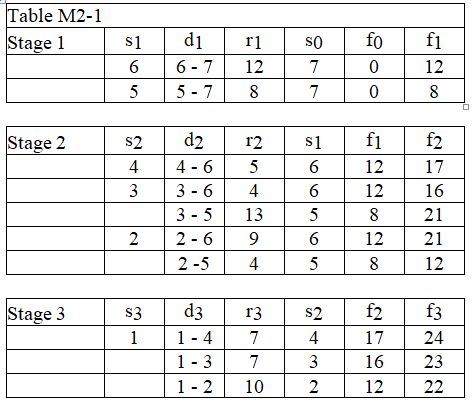
Using the data in Table M2-1, determine the distance of stage 1 for the optimal route.
A)0
B)8
C)12
D)16

Using the data in Table M2-1, determine the distance of stage 1 for the optimal route.
A)0
B)8
C)12
D)16

Unlock Deck
Unlock for access to all 86 flashcards in this deck.
Unlock Deck
k this deck
22
The following information describes a shortest-route problem with the distance in miles.What is the shortest possible route from node 1 to node 8? 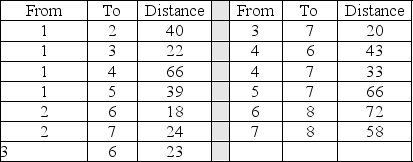
A)100
B)130
C)157
D)181

A)100
B)130
C)157
D)181

Unlock Deck
Unlock for access to all 86 flashcards in this deck.
Unlock Deck
k this deck
23
The data below is a dynamic programming solution for a shortest route problem.

According to Table M2-2, which gives a solution to a shortest route problem solved with dynamic programming, which cities would be included in the best route?
A)1, 2, 3, 4, 5, 6
B)1, 4, 6, 7
C)1, 2, 5, 6, 7
D)6, 7

According to Table M2-2, which gives a solution to a shortest route problem solved with dynamic programming, which cities would be included in the best route?
A)1, 2, 3, 4, 5, 6
B)1, 4, 6, 7
C)1, 2, 5, 6, 7
D)6, 7

Unlock Deck
Unlock for access to all 86 flashcards in this deck.
Unlock Deck
k this deck
24
The following information describes a shortest-route problem with the distance in miles.How many stages will this dynamic problem have? 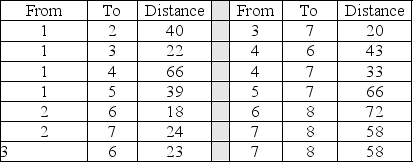
A)8
B)4
C)3
D)2

A)8
B)4
C)3
D)2

Unlock Deck
Unlock for access to all 86 flashcards in this deck.
Unlock Deck
k this deck
25
The data below is a dynamic programming solution for a shortest route problem.

Using the data in Table M2-1, determine the minimum distance from point 1 to point 7.
A)21
B)22
C)23
D)24

Using the data in Table M2-1, determine the minimum distance from point 1 to point 7.
A)21
B)22
C)23
D)24

Unlock Deck
Unlock for access to all 86 flashcards in this deck.
Unlock Deck
k this deck
26
The following information describes a shortest-route problem with the distance in miles.Which nodes are involved in the shortest route? 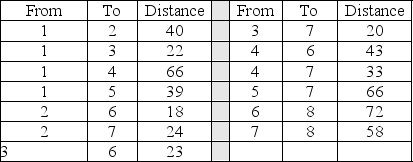
A)1-3-7-8
B)1-2-6-8
C)1-4-7-8
D)1-4-6-8

A)1-3-7-8
B)1-2-6-8
C)1-4-7-8
D)1-4-6-8

Unlock Deck
Unlock for access to all 86 flashcards in this deck.
Unlock Deck
k this deck
27
The data below is a dynamic programming solution for a shortest route problem.

Using the data in Table M2-1, determine the optimal arc of stage 1.
A)6
B)7
C)6 - 7
D)5 - 7

Using the data in Table M2-1, determine the optimal arc of stage 1.
A)6
B)7
C)6 - 7
D)5 - 7

Unlock Deck
Unlock for access to all 86 flashcards in this deck.
Unlock Deck
k this deck
28
The data below is a dynamic programming solution for a shortest route problem.

According to Table M2-2, which gives a solution to a shortest route problem solved with dynamic programming, the total distance from City 1 to City 7 is 14.What is the shortest distance from City 3 to City 7?
A)7
B)10
C)13
D)25

According to Table M2-2, which gives a solution to a shortest route problem solved with dynamic programming, the total distance from City 1 to City 7 is 14.What is the shortest distance from City 3 to City 7?
A)7
B)10
C)13
D)25

Unlock Deck
Unlock for access to all 86 flashcards in this deck.
Unlock Deck
k this deck
29
There are three items (A, B, and C) that are to be shipped by air. The weights of these are 4, 5, and 3 tons, respectively. The profits (in thousands of dollars) generated by these are 3 for A, 4 for B, and 2 for C. There are four units of each available for shipment. Only 12 tons may be loaded on the plane. The maximum possible profit for this would be
A) 7.
B) 8.
C) 9.
D) 10.
A) 7.
B) 8.
C) 9.
D) 10.

Unlock Deck
Unlock for access to all 86 flashcards in this deck.
Unlock Deck
k this deck
30
The data below is a dynamic programming solution for a shortest route problem.

Using the data in Table M2-1, what is the optimal travel path from point 1 to 7?
A)5, 7
B)6, 7
C)1, 2, 6, 7
D)1, 2, 5, 7

Using the data in Table M2-1, what is the optimal travel path from point 1 to 7?
A)5, 7
B)6, 7
C)1, 2, 6, 7
D)1, 2, 5, 7

Unlock Deck
Unlock for access to all 86 flashcards in this deck.
Unlock Deck
k this deck
31
If dynamic programming were used to solve for the minimum distance from City 1 to City 6 above, how many stages would there be?
A)6
B)5
C)4
D)3
A)6
B)5
C)4
D)3

Unlock Deck
Unlock for access to all 86 flashcards in this deck.
Unlock Deck
k this deck
32
The data below is a dynamic programming solution for a shortest route problem.

Using the data in Table M2-1, determine the distance of stage 3 for the optimal route.
A)22
B)23
C)7
D)10

Using the data in Table M2-1, determine the distance of stage 3 for the optimal route.
A)22
B)23
C)7
D)10

Unlock Deck
Unlock for access to all 86 flashcards in this deck.
Unlock Deck
k this deck
33
The data below is a dynamic programming solution for a shortest route problem.

Using the data in Table M2-1, what is the optimal arc of stage 3?
A)1
B)1 - 4
C)1 - 3
D)1 - 2

Using the data in Table M2-1, what is the optimal arc of stage 3?
A)1
B)1 - 4
C)1 - 3
D)1 - 2

Unlock Deck
Unlock for access to all 86 flashcards in this deck.
Unlock Deck
k this deck
34
There are three items (A, B, and C) that are to be shipped by air. The weights of these are 4, 5, and 3 tons, respectively, and the plane can carry 13 tons. The profits (in thousands of dollars) generated by these are 3 for A, 4 for B, and 2 for C. There are four units of each available for shipment. If this were to be solved as a dynamic programming problem, how many stages would there be?
A) 1
B) 2
C) 3
D) 4
A) 1
B) 2
C) 3
D) 4

Unlock Deck
Unlock for access to all 86 flashcards in this deck.
Unlock Deck
k this deck
35
The data below is a dynamic programming solution for a shortest route problem.

Using the data in Table M2-1, determine the optimal arc of stage 2.
A)3 - 6
B)3 - 5
C)2 - 6
D)2 - 5

Using the data in Table M2-1, determine the optimal arc of stage 2.
A)3 - 6
B)3 - 5
C)2 - 6
D)2 - 5

Unlock Deck
Unlock for access to all 86 flashcards in this deck.
Unlock Deck
k this deck
36
For the bus line problem above, what are the stages that provide the minimum distance?
A)1-2, 2-4, 4-6
B)1-2, 2-5, 5-6
C)1-3, 3-4, 4-6
D)1-3, 3-5, 5-6
A)1-2, 2-4, 4-6
B)1-2, 2-5, 5-6
C)1-3, 3-4, 4-6
D)1-3, 3-5, 5-6

Unlock Deck
Unlock for access to all 86 flashcards in this deck.
Unlock Deck
k this deck
37
For the bus line problem above, what is the minimum possible distance to travel from City 1 to City 6?
A)26
B)20
C)18
D)22
A)26
B)20
C)18
D)22

Unlock Deck
Unlock for access to all 86 flashcards in this deck.
Unlock Deck
k this deck
38
The data below is a dynamic programming solution for a shortest route problem.

Using the data in Table M2-1, determine the distance of stage 2 for the optimal route.
A)0
B)4
C)8
D)12

Using the data in Table M2-1, determine the distance of stage 2 for the optimal route.
A)0
B)4
C)8
D)12

Unlock Deck
Unlock for access to all 86 flashcards in this deck.
Unlock Deck
k this deck
39
There are six cities (City 1-City 6) serviced by a particular airline. Limited routes are available, and the distances for each of these routes are presented in the table below.
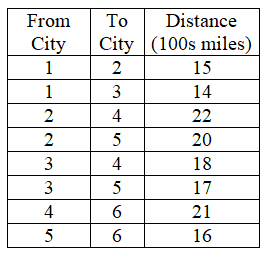
What is the minimum distance that must be traveled to get from City 1 to City 6?
A)46
B)47
C)48
D)49

What is the minimum distance that must be traveled to get from City 1 to City 6?
A)46
B)47
C)48
D)49

Unlock Deck
Unlock for access to all 86 flashcards in this deck.
Unlock Deck
k this deck
40
There are three items (A, B, and C) that are to be shipped by air. The weights of these are 4, 5, and 3 tons, respectively. The profits (in thousands of dollars) generated by these are 6 for A, 7 for B, and 5 for C. A total of 14 tons may be carried by the plane. There are four units of each available for shipment. What is the maximum possible profit for this situation?
A) 14
B) 20
C) 21
D) 22
A) 14
B) 20
C) 21
D) 22

Unlock Deck
Unlock for access to all 86 flashcards in this deck.
Unlock Deck
k this deck
41
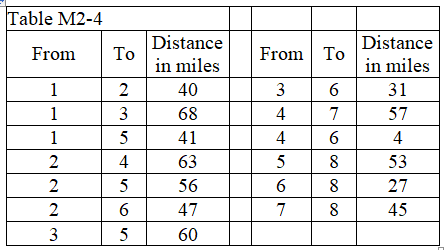
For the shortest route problem described in Table M2-4, what is the length of the shortest route?
A)205 miles
B)94 miles
C)241 miles
D)108 miles

Unlock Deck
Unlock for access to all 86 flashcards in this deck.
Unlock Deck
k this deck
42
A transformation describes
A)the relationship between stages.
B)the initial condition of the system.
C)a stage.
D)a state variable.
A)the relationship between stages.
B)the initial condition of the system.
C)a stage.
D)a state variable.

Unlock Deck
Unlock for access to all 86 flashcards in this deck.
Unlock Deck
k this deck
43
There are six cities (City 1-City 6) serviced by a particular airline. Limited routes are available, and the distances for each of these routes are presented in the table below.

Which nodes are involved in the shortest distance between City 1 and City 6?
A)1-2-4-6
B)1-2-5-6
C)1-3-4-6
D)1-3-5-6

Which nodes are involved in the shortest distance between City 1 and City 6?
A)1-2-4-6
B)1-2-5-6
C)1-3-4-6
D)1-3-5-6

Unlock Deck
Unlock for access to all 86 flashcards in this deck.
Unlock Deck
k this deck
44
A stage is a(n)
A)alternative.
B)policy.
C)condition at the end of the problem.
D)subproblem.
A)alternative.
B)policy.
C)condition at the end of the problem.
D)subproblem.

Unlock Deck
Unlock for access to all 86 flashcards in this deck.
Unlock Deck
k this deck
45
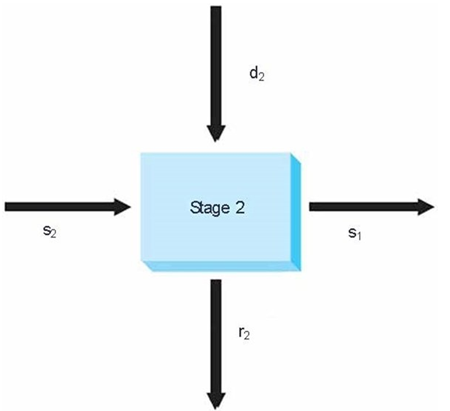
Figure M2.1
In Figure M2.1, arrow S2 represents a(n)
A)signal.
B)source.
C)stage.
D)output.

Unlock Deck
Unlock for access to all 86 flashcards in this deck.
Unlock Deck
k this deck
46
There are seven cities (City 1-City 7) served by Acme Trucking. Route availability is limited. The distances, in hundreds of miles, are given in the table below for each route.
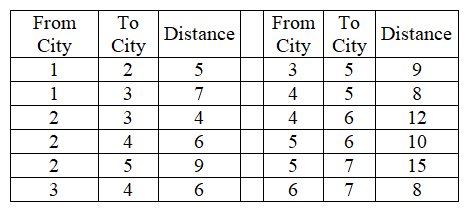
What is the minimum distance a load being moved from City 1 to City 7 must travel?
A)3000 miles
B)2900 miles
C)1500 miles
D)2700 miles

What is the minimum distance a load being moved from City 1 to City 7 must travel?
A)3000 miles
B)2900 miles
C)1500 miles
D)2700 miles

Unlock Deck
Unlock for access to all 86 flashcards in this deck.
Unlock Deck
k this deck
47
There are six cities (City 1-City 6) serviced by a particular airline. Limited routes are available, and the distances for each of these routes are presented in the table below.

What is the shortest route between City 1 and City 5?
A)29
B)30
C)31
D)32

What is the shortest route between City 1 and City 5?
A)29
B)30
C)31
D)32

Unlock Deck
Unlock for access to all 86 flashcards in this deck.
Unlock Deck
k this deck
48
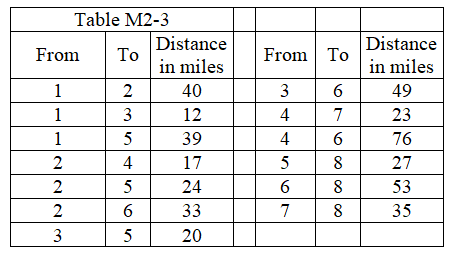
The above information describes a shortest-route problem with the distance in miles.How many stages will this dynamic programming problem have?
A)8
B)4
C)3
D)2

Unlock Deck
Unlock for access to all 86 flashcards in this deck.
Unlock Deck
k this deck
49
GATRA, the Greater Attleboro-Taunton Regional Transit Authority, serves six cities (City 1-City 6). While there are many restrictions (primarily roads on which they may not travel), they do have some choice of routes. The distances between cities, along permitted routes, are presented below.
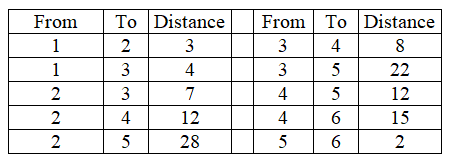
What is the minimum distance that must be traveled to get from City 1 to City 6?
A)26
B)9
C)11
D)3

What is the minimum distance that must be traveled to get from City 1 to City 6?
A)26
B)9
C)11
D)3

Unlock Deck
Unlock for access to all 86 flashcards in this deck.
Unlock Deck
k this deck
50
There are seven cities (City 1-City 7) served by Acme Trucking. Route availability is limited. The distances, in hundreds of miles, are given in the table below for each route.

If the truck were required to take the route from City 4 to City 5, what would be the overall route?
A)1-3, 3-4, 4-5, 5-6, 6-7
B)1-2, 2-4, 4-5, 5-7
C)1-2, 2-3, 3-4, 4-5, 5-6, 6-7
D)1-3, 3-5, 5-6, 6-7

If the truck were required to take the route from City 4 to City 5, what would be the overall route?
A)1-3, 3-4, 4-5, 5-6, 6-7
B)1-2, 2-4, 4-5, 5-7
C)1-2, 2-3, 3-4, 4-5, 5-6, 6-7
D)1-3, 3-5, 5-6, 6-7

Unlock Deck
Unlock for access to all 86 flashcards in this deck.
Unlock Deck
k this deck
51

For the shortest route problem described in Table M2-3, which arcs comprise the shortest route?
A)1-2, 2-6, 6-8
B)1-5, 5-8
C)1-2, 2-5, 5-8
D)1-3, 3-5, 5-8

Unlock Deck
Unlock for access to all 86 flashcards in this deck.
Unlock Deck
k this deck
52
GATRA, the Greater Attleboro-Taunton Regional Transit Authority, serves six cities (City 1-City 6). While there are many restrictions (primarily roads on which they may not travel), they do have some choice of routes. The distances between cities, along permitted routes, are presented below.

What is the shortest route?
A)1-3, 3-5, 5-6
B)1-2, 2-3, 3-4, 4-5, 5-6
C)1-3, 3-4, 4-5, 5-6
D)1-2, 2-3, 3-5, 5-6

What is the shortest route?
A)1-3, 3-5, 5-6
B)1-2, 2-3, 3-4, 4-5, 5-6
C)1-3, 3-4, 4-5, 5-6
D)1-2, 2-3, 3-5, 5-6

Unlock Deck
Unlock for access to all 86 flashcards in this deck.
Unlock Deck
k this deck
53

For the shortest route problem described in Table M2-3, what is the distance for the shortest route?
A)155 miles
B)66 miles
C)59 miles
D)114 miles

Unlock Deck
Unlock for access to all 86 flashcards in this deck.
Unlock Deck
k this deck
54

Figure M2.1
In Figure M2.1, arrow S1 represents a(n)
A)signal.
B)input.
C)stage.
D)source.

Unlock Deck
Unlock for access to all 86 flashcards in this deck.
Unlock Deck
k this deck
55
There are six cities (City 1-City 6) serviced by a particular airline. Limited routes are available, and the distances for each of these routes are presented in the table below.

Which nodes are involved in the shortest distance between City 1 and City 5?
A)1-2-5
B)1-3-5
C)1-2-3-5
D)1-2-4-5

Which nodes are involved in the shortest distance between City 1 and City 5?
A)1-2-5
B)1-3-5
C)1-2-3-5
D)1-2-4-5

Unlock Deck
Unlock for access to all 86 flashcards in this deck.
Unlock Deck
k this deck
56
There are seven cities (City 1-City 7) served by Acme Trucking. Route availability is limited. The distances, in hundreds of miles, are given in the table below for each route.

What route should the truck from City 1 to City 7 take?
A)1-2, 2-5, 5-7
B)1-3, 3-4, 4-6, 6-7
C)1-2, 2-4, 4-5, 5-6, 6-7
D)1-3, 3-5, 5-6, 6-7

What route should the truck from City 1 to City 7 take?
A)1-2, 2-5, 5-7
B)1-3, 3-4, 4-6, 6-7
C)1-2, 2-4, 4-5, 5-6, 6-7
D)1-3, 3-5, 5-6, 6-7

Unlock Deck
Unlock for access to all 86 flashcards in this deck.
Unlock Deck
k this deck
57

Figure M2.1
In Figure M2.1, arrow d2 represents a
A)decision
B)disturbance
C)d-transformation
D)dynamic node

Unlock Deck
Unlock for access to all 86 flashcards in this deck.
Unlock Deck
k this deck
58
There are four items (A, B, C, and D) that are to be shipped by truck. The weights of these are 3, 7, 4, and 5 tons, respectively, and the plane can carry 13 tons. The profits (in thousands of dollars) generated by these are 3 for A, 4 for B, 2 for C, and 5 for D. There are three units of each available for shipment. The maximum possible profit for this would be
A) $9.
B) $11.
C) $13.
D) $15.
A) $9.
B) $11.
C) $13.
D) $15.

Unlock Deck
Unlock for access to all 86 flashcards in this deck.
Unlock Deck
k this deck
59
There are four items (A, B, C, and D) that are to be shipped by truck. The weights of these are 3, 7, 4, and 5 tons, respectively, and the plane can carry 13 tons. The profits (in thousands of dollars) generated by these are 3 for A, 4 for B, 2 for C, and 5 for D. There are four units of each available for shipment. If this were to be solved as a dynamic programming problem, how many stages would there be?
A) 1
B) 2
C) 3
D) 4
A) 1
B) 2
C) 3
D) 4

Unlock Deck
Unlock for access to all 86 flashcards in this deck.
Unlock Deck
k this deck
60
There are seven cities (City 1-City 7) served by Acme Trucking. Route availability is limited. The distances, in hundreds of miles, are given in the table below for each route.

If the truck were required to take the route from City 4 to City 5, what would be the shortest distance from City 1 to City 7?
A)2900 miles
B)3200 miles
C)3700 miles
D)3400 miles

If the truck were required to take the route from City 4 to City 5, what would be the shortest distance from City 1 to City 7?
A)2900 miles
B)3200 miles
C)3700 miles
D)3400 miles

Unlock Deck
Unlock for access to all 86 flashcards in this deck.
Unlock Deck
k this deck
61
Develop the shortest-route network for the problem below, and determine the minimum distance from node 1 to node 7.
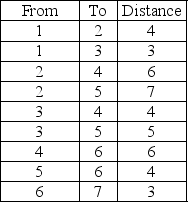


Unlock Deck
Unlock for access to all 86 flashcards in this deck.
Unlock Deck
k this deck
62
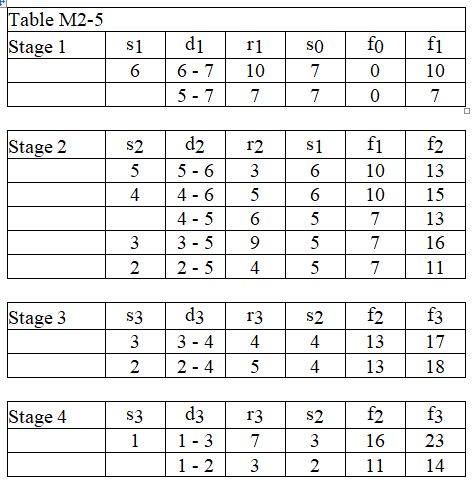
Using the data in Table M2-5, determine the optimal travel path from point 1 to point 7.
A)1 - 2, 2 - 4, 4 - 5, 5 - 7
B)1 - 2, 2 - 5, 5 - 7
C)1 - 3, 3 - 4, 4 - 5, 5 - 7
D)1 - 2, 2 - 4, 4 - 6, 6 - 7

Unlock Deck
Unlock for access to all 86 flashcards in this deck.
Unlock Deck
k this deck
63
There are four items (A, B, C, and D)that are to be shipped by air.The weights of these are 5, 7, 8, and 11 tons, respectively.The profits (in thousands of dollars)generated by these are 5 for A, 8 for B, 7 for C, and 10 for D.There are 3 units of A, 4 unit of B, 6 units of C, and 5 units of D available to be shipped.The maximum weight is 44 tons.Use dynamic programming to determine the maximum possible profits that may be generated.

Unlock Deck
Unlock for access to all 86 flashcards in this deck.
Unlock Deck
k this deck
64

Using the data in Table M2-5, determine the minimum distance from point 1 to point 7.
A)18
B)17
C)23
D)14

Unlock Deck
Unlock for access to all 86 flashcards in this deck.
Unlock Deck
k this deck
65
Hard D.Head has decided that he wants to climb one of the world's tallest mountains.He has mapped out a number of routes between various points on the mountain, and rated each route as to difficulty.His rating scale considers a 1 as being particularly easy, and a 10 as being almost impossible.
(a)Given the information below, identify the route that would provide the easiest climb.
(b)What would be the average rating of the route?
(c)What is wrong with this approach to Mr.Head's problem?
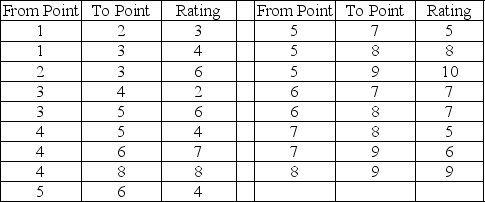
(a)Given the information below, identify the route that would provide the easiest climb.
(b)What would be the average rating of the route?
(c)What is wrong with this approach to Mr.Head's problem?


Unlock Deck
Unlock for access to all 86 flashcards in this deck.
Unlock Deck
k this deck
66

Using the data in Table M2-5, determine the optimal arc of stage 1.
A)3 - 7
B)6 - 7
C)5 - 7
D)4 - 7

Unlock Deck
Unlock for access to all 86 flashcards in this deck.
Unlock Deck
k this deck
67
GATRA, the Greater Attleboro-Taunton Regional Transit Authority, serves six cities (City 1-City 6). While there are many restrictions (primarily roads on which they may not travel), they do have some choice of routes. The distances between cities, along permitted routes, are presented below.

Which routes should be traveled?
A)1-2, 2-3, 3-5, 5-6
B)1-2, 2-3, 3-4, 4-6
C)1-2, 2-5, 5-6
D)1-4, 4-6

Which routes should be traveled?
A)1-2, 2-3, 3-5, 5-6
B)1-2, 2-3, 3-4, 4-6
C)1-2, 2-5, 5-6
D)1-4, 4-6

Unlock Deck
Unlock for access to all 86 flashcards in this deck.
Unlock Deck
k this deck
68

Using the data in Table M2-5, determine the optimal arc of stage 4.
A)1 - 2
B)2 - 4
C)1 - 3
D)3 - 4

Unlock Deck
Unlock for access to all 86 flashcards in this deck.
Unlock Deck
k this deck
69
The data below details the distances that a delivery service must travel.Use dynamic programming to solve for the shortest route from City 1 to City 8.
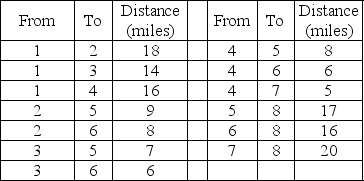


Unlock Deck
Unlock for access to all 86 flashcards in this deck.
Unlock Deck
k this deck
70

Using the data in Table M2-5, determine the optimal distance of stage 3.
A)22
B)17
C)24
D)7

Unlock Deck
Unlock for access to all 86 flashcards in this deck.
Unlock Deck
k this deck
71

Using the data in Table M2-5, determine the optimal arc of stage 2.
A)4 - 6
B)5 - 6
C)4 - 5
D)2 - 5

Unlock Deck
Unlock for access to all 86 flashcards in this deck.
Unlock Deck
k this deck
72

Using the data in Table M2-5, determine the optimal distance of stage 2.
A)10
B)7
C)8
D)11

Unlock Deck
Unlock for access to all 86 flashcards in this deck.
Unlock Deck
k this deck
73
GATRA, the Greater Attleboro-Taunton Regional Transit Authority, serves six cities (City 1-City 6). While there are many restrictions (primarily roads on which they may not travel), they do have some choice of routes. The distances between cities, along permitted routes, are presented below.

What is the minimum distance that must be traveled to get from City 1 to City 6?
A)1100 miles
B)900 miles
C)1,300 miles
D)1,400 miles

What is the minimum distance that must be traveled to get from City 1 to City 6?
A)1100 miles
B)900 miles
C)1,300 miles
D)1,400 miles

Unlock Deck
Unlock for access to all 86 flashcards in this deck.
Unlock Deck
k this deck
74
What is the decision criterion for a knapsack problem?

Unlock Deck
Unlock for access to all 86 flashcards in this deck.
Unlock Deck
k this deck
75
What is meant by a decision variable in a shortest-route problem?

Unlock Deck
Unlock for access to all 86 flashcards in this deck.
Unlock Deck
k this deck
76
Develop the shortest-route network for the problem below, and determine the minimum distance from node 1 to node 8.
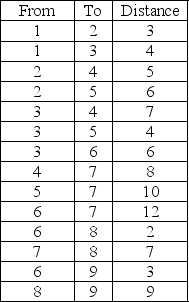


Unlock Deck
Unlock for access to all 86 flashcards in this deck.
Unlock Deck
k this deck
77
What is the decision criterion for a shortest route problem?

Unlock Deck
Unlock for access to all 86 flashcards in this deck.
Unlock Deck
k this deck
78

Using the data in Table M2-5, determine the optimal distance of stage 1.
A)0
B)8
C)7
D)14

Unlock Deck
Unlock for access to all 86 flashcards in this deck.
Unlock Deck
k this deck
79
What are the four steps in dynamic programming?

Unlock Deck
Unlock for access to all 86 flashcards in this deck.
Unlock Deck
k this deck
80

For the shortest route problem described in Table M2-4, which arcs comprise the shortest route?
A)1-2, 2-6, 6-8
B)1-3, 3-5, 5-8
C)1-5, 5-8
D)1-2, 2-4, 4-7, 7-8

Unlock Deck
Unlock for access to all 86 flashcards in this deck.
Unlock Deck
k this deck



